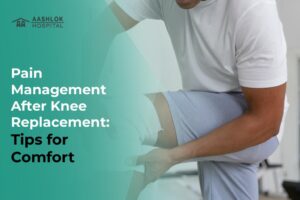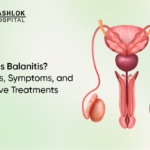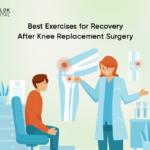Pain Management After Knee Replacement: Tips for Comfort

Undergoing knee replacement surgery is a significant step toward improving your quality of life, but it often comes with a period of post-operative discomfort. Managing pain effectively during this time is crucial for a smoother recovery. Pain after knee replacement surgery can stem from various factors, including surgical trauma and the body’s natural healing process.
Proper pain management strategies can help enhance your comfort, promote healing, and expedite your return to daily activities. Aashlok Hospital, a leading multi-specialty hospital in Delhi, offers advanced care and support to ensure a comfortable recovery process.
Read More : What to Expect from a Partial Knee Replacement Surgery?
Causes You May Feel Pain After Knee Replacement
Below are some key reasons why you may experience pain after a knee replacement.
Surgical Trauma
One of the primary reasons for post-operative pain is the trauma your body experiences during surgery. Knee replacement involves cutting through bones, muscles, and tissues, which naturally leads to inflammation and soreness. The body’s response to this trauma can cause swelling, stiffness, and pain around the surgical site.
Nerve Sensitivity
During knee replacement surgery, nerves in the surrounding area may be disturbed or irritated, leading to heightened sensitivity. This can result in sharp or shooting pains as the nerves begin to heal. Nerve-related pain may persist for several weeks or even months as the nerves regenerate.
Also Read : Best Exercises for Recovery After Knee Replacement Surgery
Inflammation and Swelling
Post-operative inflammation is a normal part of the healing process. After knee replacement, the body directs increased blood flow to the affected area to help with tissue repair. This can cause swelling, which may compress nerves and contribute to discomfort. Managing inflammation is key to reducing pain and enhancing mobility during recovery.
Scar Tissue Formation
As your knee heals, scar tissue forms around the surgical site. While this is a natural part of the healing process, excessive scar tissue can restrict movement and cause pain. In some cases, physical therapy may be required to help break down scar tissue and restore full function to the knee.
Muscle Weakness and Imbalance
After knee replacement surgery, the muscles around the knee may weaken due to reduced activity. This muscle weakness can lead to imbalances that put additional strain on the knee joint, resulting in pain. Strengthening exercises and physical therapy are essential for rebuilding muscle strength and ensuring proper joint support.
Read More : All you need to know about – knee surgery
Tips for Managing Pain After Knee Replacement
Effectively managing pain after knee replacement is vital for a smooth recovery and a quicker return to normal activities. While discomfort is expected, there are several strategies you can employ to reduce pain and enhance healing. By following these knee replacement tips, you can minimize pain and support your body’s natural recovery process.
Follow Your Doctor’s Pain Management Plan
Your healthcare provider will prescribe a pain management plan tailored to your specific needs. This may include medications such as opioids, non-steroidal anti-inflammatory drugs (NSAIDs), and acetaminophen. Follow the prescribed dosage and schedule to keep pain under control and avoid potential complications.
Aashlok Hospital’s orthopedic team offers personalized care plans to ensure optimal pain relief, helping you navigate your recovery with ease.
Use Cold Therapy
Applying ice packs to the surgical site can help reduce inflammation and numb the area, providing temporary pain relief. Cold therapy is most effective when used in the first few days after surgery. Apply an ice pack for 15-20 minutes at a time, several times a day, to minimize swelling and discomfort.
Stay Active with Gentle Exercises
While rest is important, staying active with gentle exercises can help prevent stiffness and improve circulation. Simple activities like ankle pumps, leg lifts, and walking with support can promote healing and reduce pain. Your physical therapist will guide you through exercises designed to strengthen the muscles around your knee and enhance your range of motion.
Aashlok Hospital offers comprehensive rehabilitation services, including tailored exercise programs that are crucial for a successful recovery.
Elevate Your Leg
Elevating your leg above heart level can help reduce swelling and alleviate pain. Use pillows to prop up your leg while resting or sleeping, ensuring that your knee is supported. Elevation helps drain excess fluid from the knee area, reducing pressure on the surgical site and promoting comfort.
Read More : Knee Replacement Cost in India: How to Choose the Right Surgeon and Hospital
Stay Hydrated and Eat a Balanced Diet
Proper hydration and nutrition are essential for recovery. Drinking plenty of water and eating a balanced diet rich in protein, vitamins, and minerals can aid in tissue repair and reduce inflammation. Foods rich in omega-3 fatty acids, such as fish and nuts, have anti-inflammatory properties that can further help manage pain.
Use Assistive Devices as Recommended
Using assistive devices such as crutches, walkers, or canes can reduce strain on your new knee and minimize pain during movement. Follow your healthcare provider’s recommendations regarding when and how to use these devices. Gradually transition to walking without assistance as your strength and balance improve.
Practice Deep Breathing and Relaxation Techniques
Managing pain is not just about physical interventions; mental and emotional well-being also play a significant role. Deep breathing, meditation, and other relaxation techniques can help you cope with pain by reducing stress and promoting a sense of calm. These practices can also improve your overall recovery experience.
Monitor for Signs of Complications
While pain is a normal part of the healing process, it’s important to monitor for signs of complications such as infection, blood clots, or severe swelling. If you experience excessive pain, redness, warmth, or other unusual symptoms, contact your healthcare provider immediately.
Aashlok Hospital’s 24/7 emergency services are always available to address any concerns you may have during your recovery, ensuring your safety and peace of mind.
Read More : 5 Ways To Manage Pain After Knee Replacement
Conclusion
Managing pain after knee replacement surgery is essential for a successful recovery. By following your doctor’s advice, staying active, and using supportive techniques, you can minimize discomfort and enhance your healing process. Remember that Aashlok Hospital is committed to providing exceptional care and support throughout your recovery journey, ensuring that you receive the best possible outcomes.
FAQs
What are the common reasons for needing a knee replacement?
Knee replacement surgery is often required due to severe arthritis, particularly osteoarthritis, which causes the cartilage in the knee joint to wear away, leading to pain and limited mobility. Other reasons include rheumatoid arthritis, traumatic injuries, or deformities.
How long is the typical recovery period after knee replacement surgery?
The typical recovery period after knee replacement surgery ranges from 6 to 12 weeks. During this time, patients gradually regain mobility and strength, with most being able to return to normal activities within three months, though full recovery can take up to a year.
Are there any alternative treatments to consider before opting for a knee replacement?
Before opting for knee replacement, alternative treatments such as physical therapy, weight loss, corticosteroid injections, and pain management medications may be considered. These options can help alleviate symptoms and improve joint function without surgery.
How can I prepare my home for a smoother recovery post-knee replacement surgery?
To prepare your home for a smoother recovery, arrange a living space on one level to minimize the need for stairs, remove tripping hazards, install handrails, and ensure that commonly used items are within easy reach. Consider setting up a comfortable recovery area with supportive seating and easy access to essentials.










